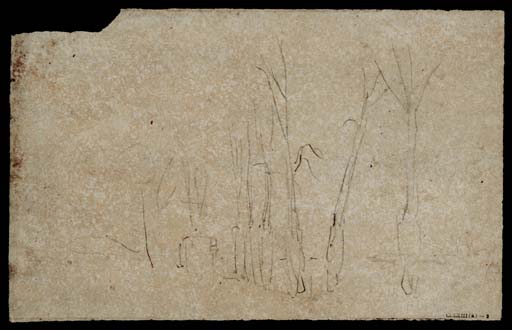J.M.W. Turner
>
1819-29 Italy and after
>
Thames, London and South of England 1821 ...
>
Studies at 'The Limes', Mortlake
>
Artwork
2 of 4 artworks
Joseph Mallord William Turner The Summer-house and Garden at 'The Limes', Mortlake, Looking West up the River Thames ?1826
Image 1 of 2
Joseph Mallord William Turner,
The Summer-house and Garden at 'The Limes', Mortlake, Looking West up the River Thames
?1826
Joseph Mallord William Turner 1775–1851
The Summer-house and Garden at ‘The Limes’, Mortlake, Looking West up the River Thames ?1826
D25517
Turner Bequest CCLXIII a 2
Turner Bequest CCLXIII a 2
Pencil on white wove paper, 145 x 228 mm
Blind-stamped with Turner Bequest monogram towards bottom right
Stamped in black ‘CCLXIII(a) – 2’ bottom right
Blind-stamped with Turner Bequest monogram towards bottom right
Stamped in black ‘CCLXIII(a) – 2’ bottom right
Accepted by the nation as part of the Turner Bequest 1856
References
1909
A.J. Finberg, A Complete Inventory of the Drawings of the Turner Bequest, London 1909, vol.II, p.845, CCLXIII a 2, as ‘Mortlake Terrace’. c.1820–30.
1983
Evelyn Joll, in John Gage, Jerrold Ziff, Nicholas Alfrey and others, J.M.W. Turner, à l’occasion du cinquantième anniversaire du British Council, exhibition catalogue, Galeries nationales du Grand Palais, Paris 1983, p.101 under no.36 as undated study.
1984
Martin Butlin and Evelyn Joll, The Paintings of J.M.W. Turner, revised ed., New Haven and London 1984, p.148 under no.239.
1992
John Hayes, British Paintings of the Sixteenth through Nineteenth Centuries, The Collections of the National Gallery of Art Systematic Catalogues, Washington 1992, p.270.
This sketch relates to Turner’s oil painting Mortlake Terrace, the Seat of William Moffatt, Esq. Summer’s Evening, shown at the Royal Academy in 1827 (National Gallery of Art, Washington, DC).1 As noted in the Introduction to the present subsection, this is one of four drawings which are supplementary or complementary to studies in the Mortlake and Pulborough sketchbook (Tate; Turner Bequest CCXIII), probably in use at Mortlake in 1825. The direct source for Summer’s Evening is a double-page Mortlake and Pulborough sketch (Tate D18733–D18734; Turner Bequest CCXIII 15a–16), and the juxtaposition of the tree trunks in the latter is followed very closely in the painting. The spacing and details of the trees in the present view suggest it was drawn independently on the spot from a viewpoint nearer to the summer-house. Compare also Tate D25516 (Turner Bequest CCLXIII a 1), a rather more detailed reprise of the same subject.
Technical notes:
Finberg describes the work as in ‘Pencil and white chalk on grey’ paper,1 but in common with the other three separate Mortlake studies (Tate D25516, D25518, D34018; Turner Bequest CCLXIII a 1, 3, CCCXLI 299) the paper appears merely off-white, presumably through age, with brown mottling, more prominent and extensive here than on the other sheets. There is now no obvious evidence of the white chalk he mentions.
The edges are all slightly irregular, and the bottom edge appears to have been formed by folding a larger sheet and tearing along the fold, as there is appears to be a shallow remnant below the fold. There is an irregular piece missing at the top left, measuring some 14 x 51 mm, which may relate to the shallow diagonal creases at the top right of both D25516 and D25518 and the top left of D34018, suggesting that the four sheets were at least initially kept together.
Verso:
Blank (laid down).
Matthew Imms
December 2014
How to cite
Matthew Imms, ‘The Summer-house and Garden at ‘The Limes’, Mortlake, Looking West up the River Thames ?1826 by Joseph Mallord William Turner’, catalogue entry, December 2014, in David Blayney Brown (ed.), J.M.W. Turner: Sketchbooks, Drawings and Watercolours, Tate Research Publication, April 2015, https://www


